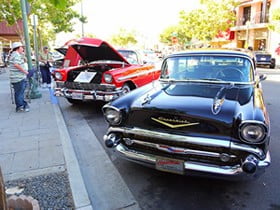Table of Contents
So what sort of Job or work are you looking for and as important where do you want to live?
Are you a personal banker, quantitative analyst, sales executive, or wherever your work experience and objectives are, finding a good employer, a nice environment to work and live is critical to everyone’s happiness and wellbeing.
Did you consider working outside of the USA?
Where will you live, what about work permits and visas, inside our site you will find lots of information and links that will answer all your questions.
Lets cover off Escondido first. Escondido is a city located in California, just north of the city of San Diego. The name means “hidden” in Spanish it occupies a shallow valley ringed by rocky hills. Founded in 1888, it is one of the oldest cities in San Diego County.
The city has an estimated population of 128,819. The city is known as ‘Eskondiid in Diegueño. A nationwide study in 2005 ranked Escondido #11 out of 25 of the most conservative cities in America.
Incorporation and growth
The city was home to a large Spanish-speaking population in the first census back in 1850, but after the US won the war, non-Hispanic settlers came to Southern California in increasing numbers. The decade of the 1880s is known as the “Southern California Land Boom” because so many people were moving to the state.
 In October 1883, a group of Los Angeles investors purchased Rancho Rincon del Diablo. This group sold the land to the newly-formed Escondido Company in 1884. On December 18, 1885, investors incorporated the Escondido Land and Town Company, and in 1886 this company purchased the 12,814-acre (52 km2) area for approximately $100,000.
In October 1883, a group of Los Angeles investors purchased Rancho Rincon del Diablo. This group sold the land to the newly-formed Escondido Company in 1884. On December 18, 1885, investors incorporated the Escondido Land and Town Company, and in 1886 this company purchased the 12,814-acre (52 km2) area for approximately $100,000.
Two years later, in 1888, Escondido was incorporated as a city – the vote was 64 in favor of cityhood with 12 votes against. Railroads like the Santa Fe and Southern Pacific were laid in the 1880s, and the opening of U.S. Route 395 in 1930 boosted economic growth in Escondido.
Escondido was primarily an agricultural community, growing muscat grapes initially. After a dam was built in 1894-5 to form what is known today as Lake Wohlford, oranges and lemons were planted in large quantity, as well as a number of olives and walnuts. By the 1960s avocados became the largest local crop. Since the 1970s, Escondido has lost most of its agricultural landscape to new housing developments.
Downtown
 Downtown Escondido (centered on Grand Avenue) has become more active in the past few years with the opening of restaurants, cafes, and galleries.
Downtown Escondido (centered on Grand Avenue) has become more active in the past few years with the opening of restaurants, cafes, and galleries.
Every Friday night from April through September, the Downtown Business Association hosts the popular “Cruisin’ Grand,” where the public can show and view hot rods and historic cars.
A different car club and/or featured attraction is highlighted each week. Cruisin’ Grand also features a DJ, hula hoop contests for children, and 7 trophies each night.
The city is growing at a rapid rate with new communities like Hidden Trails appearing at the east end of E Valley Pkwy. The city proper is surrounded by several sparsely populated unincorporated communities. These include Jesmond Dene and Hidden Meadows to the north; Felicita Park to the southwest; and Rincon Del Diablo to the southeast.
 Residents of these communities have Escondido mailing addresses and zip codes, and they are sometimes assigned to Escondido schools, but they can’t participate in city-wide elections, such as elections of city council.
Residents of these communities have Escondido mailing addresses and zip codes, and they are sometimes assigned to Escondido schools, but they can’t participate in city-wide elections, such as elections of city council.
A major tourist attraction just outside Escondido is the San Diego Wild Animal Park, sister park of the San Diego Zoo.
Escondido tends to have warmer summers and wetter winters than its neighbor San Diego. Yearly precipitation averages around 15 inches and varies from year to year. More than 80% of all precipitation takes place from November through March. Snow is very uncommon. Climate is mild enough to allow widespread cultivation of avocados and oranges.
Economy
 Residents work in a range of industries.
Residents work in a range of industries.
Out of the approximately 64,000 employed civilian residents over the age of 16, 15% work in educational, health care and social services; 13% in retail trade; 13% in construction; 12% in professional, scientific, management, administrative, and waste management services; 11% in arts, entertainment, recreation, and accommodation and food services; 11% in manufacturing; and 11% in other services
Top Employers
According to the City’s 2009 Comprehensive Annual Financial Report, the top employers in the city are:
| # | Employer | # of Employees |
|---|---|---|
| 1 | Palomar Medical Center | 2,664 |
| 2 | Escondido Union School District | 1,795 |
| 3 | City of Escondido | 1,075 |
| 4 | Escondido Union High School District | 715 |
| 5 | North County Transit District | 484 |
| 6 | ARS National Services | 439 |
| 7 | Nordstrom | 418 |
| 8 | Ne-Mo’s Bakery | 352 |
| 9 | Palomar College | 340 |
| 10 | The Home Depot | 333 |
Escondido Employment Statistics
|
|
||||||||||||||||||||||||||||||||||||||||||||||||||||||||||||||||||||||||||||||||||||||||||||||||||||||||||||||||||||